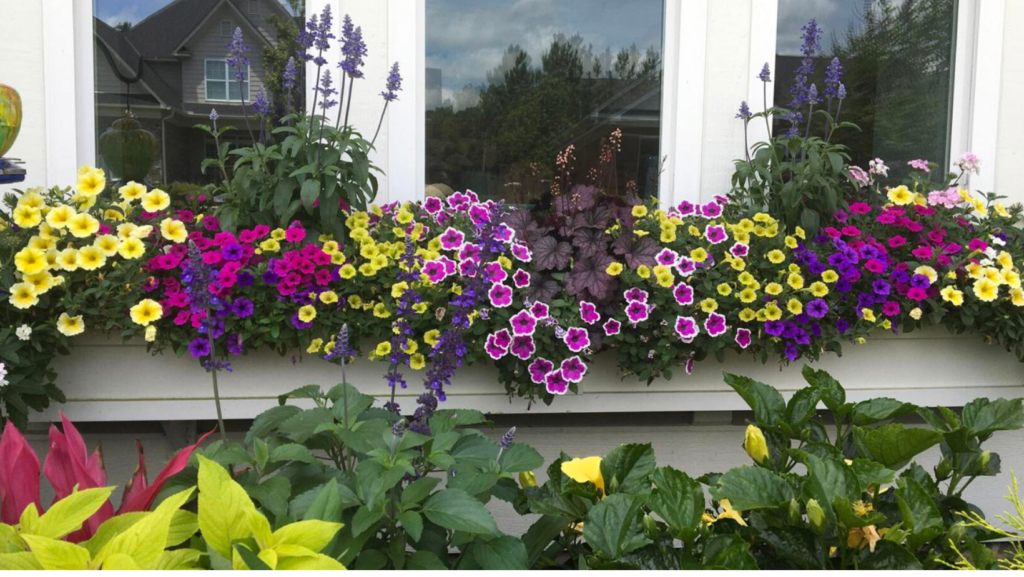With their unique blend of appeal and performance, these two flowering superstars have become mainstays in summer container displays. However, selecting between Superbells and Supertunias can feel like navigating a confusing maze of flowers because there are so many options available.
Let us first go back a little. Do you recall the beloved petunia? For many years, these adorable trumpet-shaped flowers were a staple in gardens, lending a whimsical touch to any sunny area. Petunias were known to be a little picky, though, needing regular deadheading (removing wasted flowers) and occasionally falling ill. The Supertunia’s genesis! Larger flowers, enhanced disease resistance, and a stronger, more weather-tolerant shape are all features of this hybrid petunia that make it a superstar.
In response to gardeners’ demands for even more tumbling color, breeders focused on cultivating the Calibrachoa, also known as “million bells” due to its prodigious flowering behavior. Similar to petunias, calebrachoas were prized for their color, but they also had drawbacks, such as being slightly more susceptible to overwatering.
The Superbells were created via more magical mating! With enhanced water tolerance and self-cleaning characteristics, these hybrid Calibrachoas absorbed the eye-catching color palette of its parent plant and don’t need deadheading to continue flowering profusely! Which one should you choose, you ask, given that Supertunias and Superbells both provide a colorful, low-maintenance experience?
Supertunia vs. Superbells
| Feature | Supertunia (Petunia) | Superbells (Calibrachoa) |
|---|---|---|
| Plant Type | Bred for better performance petunia | Prolific blooming calibrachoa |
| Flower Size | Larger | Smaller |
| Water Needs | More tolerant of moist soil | Prefers slightly moist soil, sensitive to overwatering |
| Sun Preference | Full sun for best flowering | Full sun for best flowering |
| Deadheading | May require deadheading | Self-cleaning (doesn’t require deadheading) |
| Winter Hardiness | Not frost tolerant (annual) | Not frost tolerant (annual) |
| Disease Resistance | Generally good | Generally good |
| Color Range | Wide variety available | Wide variety available |
| Growth Habit | Mostly trailing or mounding | Mostly mounding and trailing |
| Landscaping Use | Containers, hanging baskets, bedding (in some regions) | Containers, hanging baskets, spilling over edges |
Supertunia (Petunia)
Supertunia petunias are unlike any other garden kind. It’s a carefully cultivated powerhouse that grows well in hanging baskets, containers, and even landscapes (in warmer climates). It has an amazing range of colors and large, robust flowers. Let’s examine each of Supertunia’s outstanding qualities in more detail:

1-Type of Plant: An Improved Petunia
Supertunia originated from the vision of enthusiastic breeders who wanted to bring the popular petunia to new heights. Through meticulous variety selection and crossbreeding, they have produced a plant that exudes:
Enhanced Performance: Throughout the season, supertunias produce an abundance of blooms due to their aggressive growth habits. Compared to conventional petunias, they have a greater branching habit, which makes for a bushier plant with more flowers.
Enhanced Disease Resistance: Supertunia cultivars frequently exhibit heightened resilience against prevalent petunia diseases, such as powdery mildew and botrytis blight. This means that your plant will require less care and be healthier and more colorful throughout the summer.
Extended Blooming: Deadheading petunia blossoms is a thing of the past. Since spent blooms naturally fall off, supertunias are typically “self-cleaning,” meaning they always generate new flowers. This lets you just kick back and take in the show, doing away with the continuous deadheading.
2-Growth Habit
Supertunia’s flexibility is what makes it so beautiful. Depending on the particular kind you select, you might anticipate either a:
Trailing Habit: Supertunias are a great option if you’re looking for a plant that will trail color in window boxes or hanging baskets. These cultivars cascade beautifully over the periphery, giving a vivid display of blossoms. They look amazing in raised planters or pots with tiers, letting the petals cascade down in a captivating show.
Stacking Behavior: Do you like a rounded, more compact look? Supertunias mounding are a great option. They create a thick pile of flowers that are perfect for your flower beds or containers. You can use them as accents among other greenery or plant them closer together to create a solid mass of color.
3-Blossom Size
Among its petunia cousins, the supertunia holds the title for largest flowers with pride. Their blooms usually have a striking visual impact since they are bigger and more robust.
Visual Feast: Bolder visual statements are inherently derived from larger blooms. The blossoms of supertunias can grow up to 3 inches in diameter, making them much larger than the blooms of many regular petunias. This results in a more lavish and spectacular presentation that leaves a lasting effect on everyone who sees them.
Color Explosion: Supertunia’s blossoms have a larger canvas, so their color really pops. From traditional pinks, purples, and reds to more uncommon tones like bicolors, veined patterns, and even lime green, they are available in an astounding assortment of vivid hues. With such a wide range to choose from, you may design a custom color scheme that accentuates your outside area.
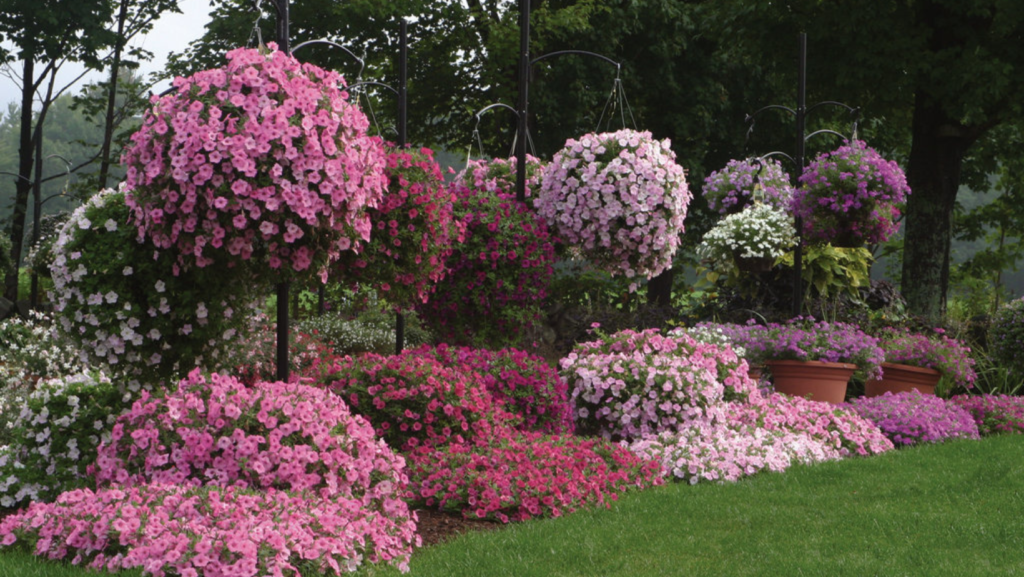
4-Water Requirements
It is in a pleasant medium of moisture that supertunia grows. Compared to Superbells (Calibrachoa), they can tolerate slightly moister soil, although they still like well-draining soil. Here’s how to find the ideal equilibrium:
Preventing Soggy Soil: Supertunia (and other plants, for that matter) are frequently harmed by overwatering. Make sure the pores in your container can drain extra water. Wet soil can cause wilting, stunted growth, and root rot.
Watering Prudently: The best practice is to give your Supertunias water when the top inch of soil is feeling arid. You may need to water more regularly in hot, sunny weather and less frequently in chilly weather. Keep an eye on your plant and modify your watering regimen as necessary.
5-Sun Preference
Supertunias need lots of sunshine to reach their full blossoming potential. What you should know is as follows:
Sun Seeker: Try to give your Supertunia six to eight hours a day in direct sunshine. This will guarantee bright, robust growth and promote the best possible bloom yield.
Getting Used to the Shade: Supertunias prefer full sun, although they can also handle moderate afternoon shade, particularly in very warm climates. In shaded areas, however, expect slightly fewer flowers and slower growth.
6-Deadheading
Supertunia’s ability to clean themselves is one of its most enticing features. Supertunias typically take care of deadheading (removing wasted flowers) on their own, in contrast to ordinary petunias that need continuous assistance.
Lower Maintenance: New buds are continuously created while spent flowers fall off organically, resulting in a smooth color cycle. This means you’ll be able to spend more time appreciating your garden’s colorful show and less time deadheading.
Encourage More Blooms: Supertunias usually self-clean, but sometimes they will benefit from a little deadheading here and there. Just trim spent flowers with a pinch at the base of the stem, being careful not to pull off any leaves.
7-Winter Hardiness
Supertunias cannot withstand ice, much like most other petunias. In most climes, they are regarded as annuals, meaning that they finish their life cycle in a single growing season.
Savoring the Season: When the risk of frost has passed in the spring, plant your Supertunia outdoors. They’ll flourish all summer and fall, giving off a steady stream of color until the first frosts appear in late fall.
Techniques for Overwintering in Milder Climates: It’s possible to try overwintering your Supertunia in zones 9–10 with quite mild winters. Before the first frost, bring the container indoors and set it in a bright area. Water less and apply fertilizer sparingly. But remember that overwintering does not always ensure success.
8-Disease Resistance
Supertunias are naturally resistant to a lot of common petunia diseases, which can save you time and work when it comes to keeping them healthy.
Built-in Defenses: When developing Supertunia cultivars, breeders give priority to disease resistance. This means that your plants will be less vulnerable to fungal diseases like powdery mildew, which forms white, powdery patches on leaves, and botrytis blight, which rots blossoms and buds.
Preventive measures: Supertunia has good disease resistance, but the risk can be further reduced with appropriate planting methods and hygienic gardening practices. Make sure there’s adequate airflow around the plants, steer clear of crowding, and water from the base of the plant instead of above.
9-Color Range
The remarkable range of colors found in supertunias is one of its main selling points. There’s a Supertunia to fit your concept, whether you want a timeless style or an enthralling combination:
Traditional Beauty: Embrace classic hues such as vivid pinks, reds, purples, and whites. Any outdoor area is made seem cozy and upbeat by these hues.
Bicolored Delights: Look at Supertunia cultivars that have two contrasting hues on each bloom for more visual intrigue. These bicolors give your color scheme depth and a captivating look.
Veined Elegance: Select Supertunia cultivars with striking veins crisscrossing the petals for a hint of refinement. These blossoms produce a distinctive and striking arrangement.
Unexpected Colors: Experiment by growing Supertunia kinds in odd hues such as lavender, lime green, and even bi-colored combinations with unique patterns. These distinctive choices can really bring attention to your yard.
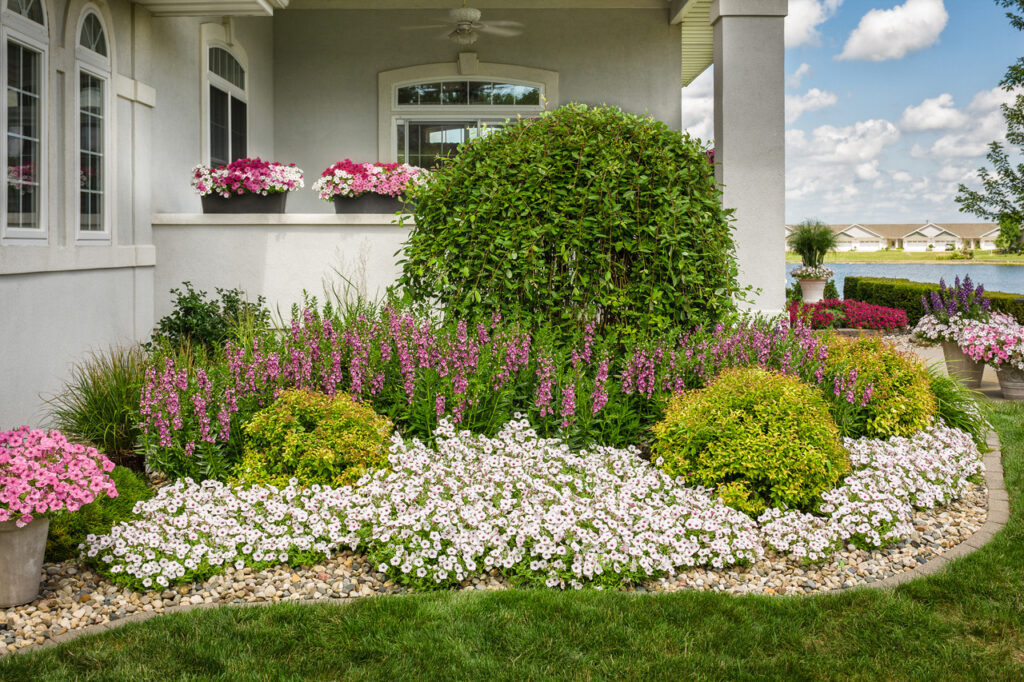
10-Landscaping Use
Supertunia is ideal for a range of landscaping applications due to its versatility.
Supertunia is a natural for window boxes, hanging baskets, and other containers. Their colorful blooms and trailing or mounding behaviors produce an amazing cascading or overflowing impression.
Bedding Brilliance: Supertunia can be used as bedding plants in warmer climates (zones 9–10), bringing a pop of color to your flower beds. Use them as highlights among other foliage, or plant them closer together to create a solid mass of color.
Marvels in Mixed Containers: Supertunia gets along well with others! For a very beautiful and varied display in your containers, combine them with other flowering annuals or plants that have complimentary leaves.
Superbells (Calibrachoa)
Superbelle isn’t an ordinary flower from the garden. These little beauties from the Calibrachoa species are small and manageable in size, but they deliver a big punch in terms of color and charm. Superbells, which bloom profusely and clean up after themselves, are a low-maintenance option for bringing color to hanging baskets, overflowing borders, and containers in your garden.
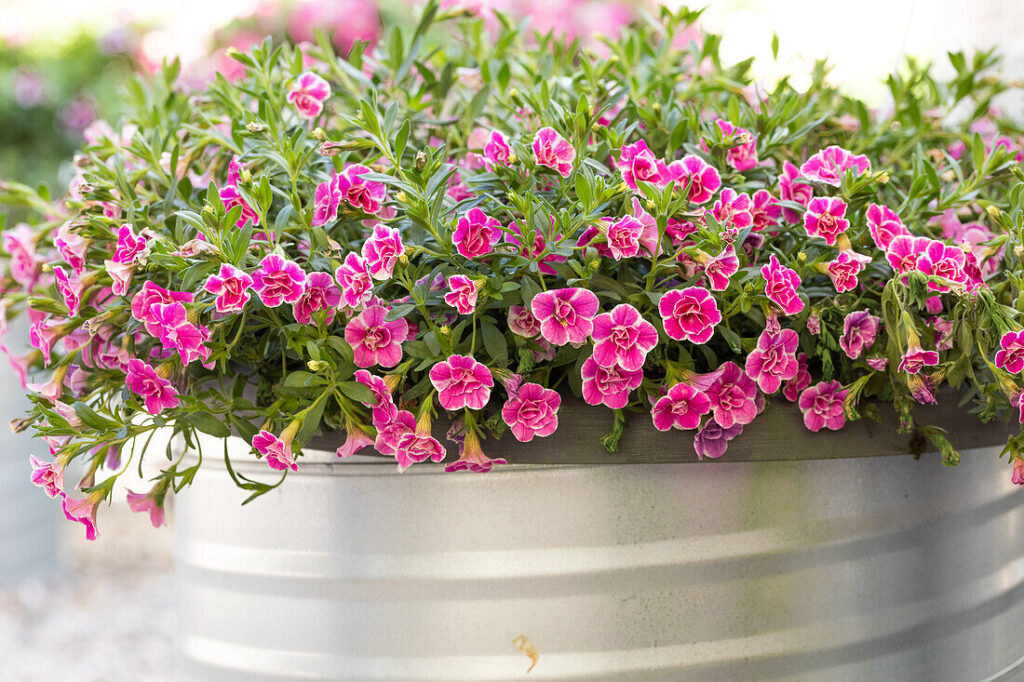
1-Type of Plant
Superbells are the result of careful breeding in the family Calibrachoa. Despite having a similar appearance to petunias, these flowering plants have a few distinctive qualities of their own:
Prolific Bloom Power: The extraordinary blossoming power of superbells is well known. They consistently yield an abundance of tiny, trumpet-shaped flowers all season long. They are a great addition to any garden because of their constant display of color, which brings life and happiness from spring to October.
Compact and Manageable: Superbells are typically smaller and easier to handle than their giant petunia siblings. They are therefore perfect for border flower beds, hanging baskets, and smaller containers. Their trailing or bushy habit lends itself to imaginative planting combinations, spilling over container edges or lending a cascading accent to raised pots.
Various Variations: Superbells come in a beautiful assortment of colors, patterns, and even leaf types thanks to the hard work of breeders who have carefully grown a wide range of Superbells variants. Superbells come in a range of hues to match every taste and color scheme, from traditional pinks and purples to more eye-catching bicolors, veined patterns, and even lime green.
2-Growth Habit
Superbells are beautiful because they may be grown in a variety of ways. Whichever particular variety you select, you can anticipate either:
Bushy Abundance: Mounding Superbells are an excellent option for bringing vibrant splashes of color into flower beds or containers. Their dense pile of blossoms, produced by their compact and bushy growth habit, is perfect for filling in spaces or adding a solid mass of color to your garden design. Planting them closer together intensifies this impact, turning your area into a colorful flower tapestry.
Cascading Elegance: Trailing Superbells give window boxes, hanging baskets, and raised planters a hint of elegant whimsy. Their flower-adorned cascading vines produce a captivating waterfall of color that’s ideal for bringing some vertical appeal to your patio or balcony. Picture bright flowers falling from your hanging basket and swinging softly in the warm wind.
3-Flower Size
Supertunias are larger than superbells, but superbells are more charming because of their delicate elegance and sheer number of blossoms. When grouped together, these tiny blossoms, which usually have a diameter of 1 to 2 inches, provide a striking and captivating sight.
A Sea of Color: Superbells are smaller, but they make up for it with their frequent blooming schedule. Larger-flowered types can’t match the vivid sea of color created by the sheer quantity of blossoms. Envision an abundant hanging basket filled with hundreds of tiny flowers, each contributing a subtle yet exquisite touch to your outdoor area.
Versatility in Design: Superbells are highly adaptable in terms of design because of their smaller blossom size. In mixed containers, they can be utilized to produce complex color combinations that add interest and contrast wonderfully with larger-flowered companions. This enables you to design unique color schemes and inventive combinations for your yard.
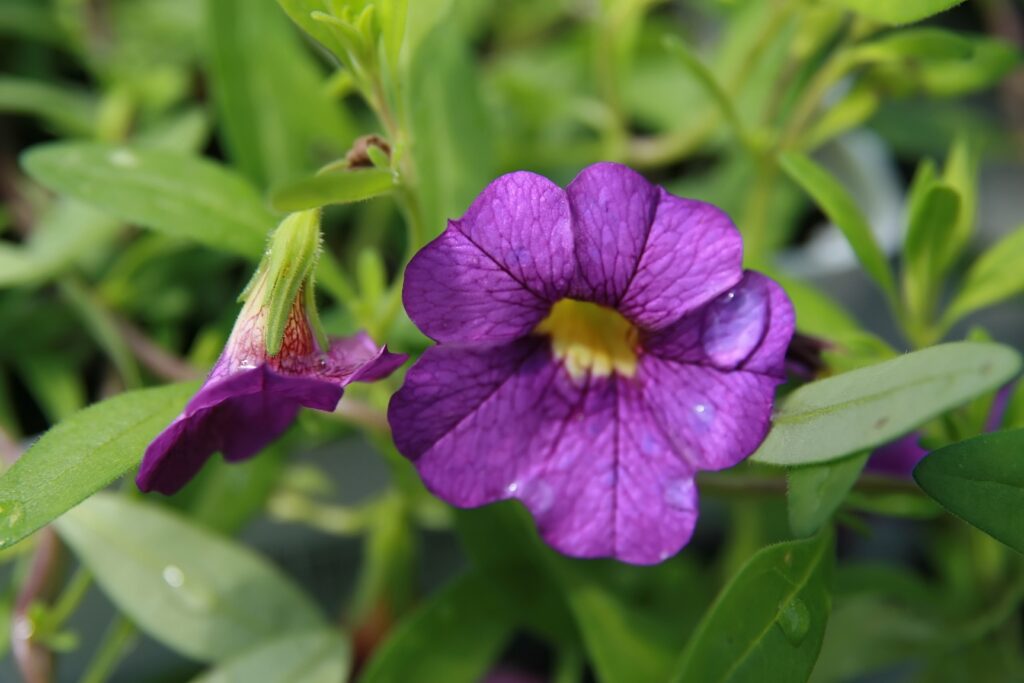
4-Water Requirements
Superbells are slightly more susceptible to overwatering than their Supertunia counterparts. They need good drainage to avoid root rot, but they love somewhat damp soil. Here’s how to find the ideal equilibrium:
Preventing the dreaded sog: One of the main reasons Superbells have problems is overwatering. Make sure the openings in your containers can drain extra water. Wet soil can cause wilting, stunted growth, and root rot very quickly. Always keep in mind that it’s preferable to be slightly submerged than overwater.
The Craft of Prudent Watering: Checking the soil moisture frequently is the best practice when it comes to watering Superbells. When the top inch of soil appears dry to the touch, deeply water the area. You may need to water more regularly in hot, sunny weather and less frequently in chilly weather. Keep an eye on your plants and modify your watering regimen as necessary.
5-Sun Preference
Superbells need enough sunlight in order to flourish and reach their full blossoming potential. What you should know is as follows:
Under the Full Sun (Second): Your Superbells will bloom profusely and with the brightest blooms if they get enough of sunshine. This will result in a consistent display of color that will enliven your landscape all season long.
Adapting to Shade (Somewhat): Superbells can withstand some afternoon shade, especially in extremely hot conditions, although full sun is best. In shaded areas, however, expect slightly fewer flowers and slower growth. If your alternatives for sunshine are limited, think about planting Superbells in a spot that gets morning sun and some afternoon shade.
6-Deadheading
Superbells’ ability to clean themselves is one of their most alluring features. Superbells typically take care of deadheading (removing wasted flowers) on their own, in contrast to certain other flowering plants that need ongoing assistance.
A Low-Maintenance Pleasure: New buds are constantly created while spent flowers fall off organically, resulting in a smooth color cycle. This means you’ll be able to spend more time appreciating your garden’s colorful show and less time deadheading. But there are a few advantages to light deadheading once in a while:
Promoting Additional Blooms: Even though self-cleaning, a little bit of deadheading every now and then can occasionally promote new blooms. Just trim spent flowers with a pinch at the base of the stem, being careful not to pull off any leaves. This can encourage the plant to form more bloom buds, which will improve the color show as a whole.
7-Winter Hardiness
Superbells are not frost tolerant, just as the majority of Calibrachoa cultivars. In most climes, they are regarded as annuals, meaning that they finish their life cycle in a single growing season.
Savouring the Season: When the risk of frost has passed in the spring, plant your superbells outside. They’ll flourish all summer and fall, giving off a steady stream of color until the first frosts appear in late fall.
Techniques for Overwintering in Less Severe Climates: You might try to overwinter your Superbells in zones 9–10, which have quite moderate winters. Before the first frost, bring the container indoors and set it in a bright area. Water less and apply fertilizer sparingly. But remember that overwintering does not always ensure success.
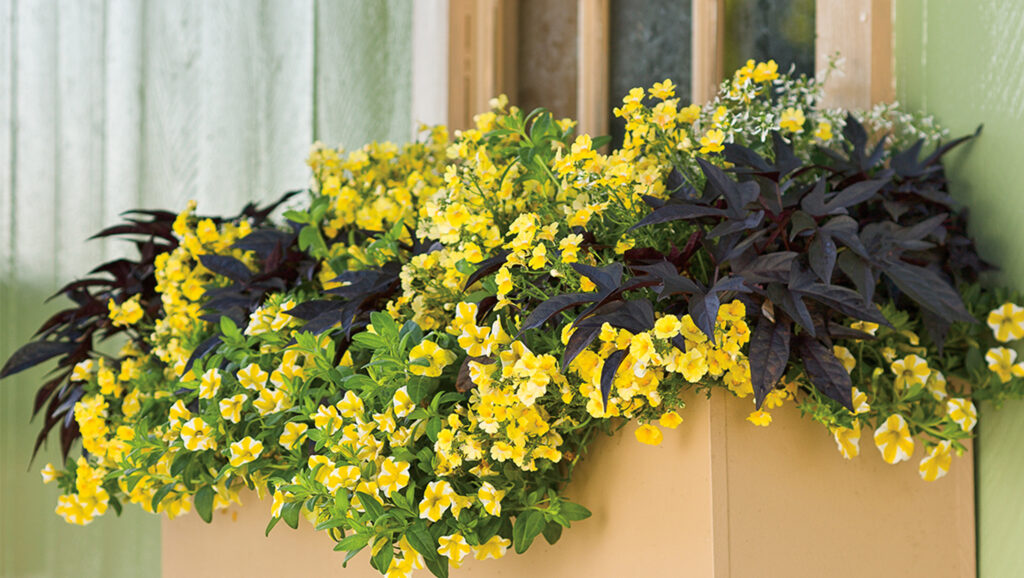
8-Disease Resistance
Superbells save you time and effort in maintaining their health because they naturally resist several typical Calibrachoa diseases.
Built-in Defenses: When developing Superbells cultivars, breeders give priority to disease resistance. This means that there will be less vulnerability to issues like as botrytis blight, a fungal disease that rots blooms and buds. But you may reduce the risk even more by using smart gardening practices and planting strategies.
Preventive actions: Superbells are a good disease-resistant plant, but you may reduce the danger even more by using basic gardening practices and planting procedures. Make sure there’s adequate airflow around the plants, steer clear of crowding, and water from the base of the plant instead of above.
9-Color Palette
Superbells have an even greater range of colors than their Supertunia siblings. If you’re looking for a traditional or intriguing blend, Superbells has a choice to fit your vision:
Traditional Beauty: Embrace classic hues such as vivid pinks, reds, purples, and whites. Any outdoor area is made seem cozy and upbeat by these hues.
Bicolored Delights: Look at Superbells cultivars that have two contrasting hues on each bloom for more visual intrigue. These bicolors give your color scheme depth and a captivating look.
Veined Elegance: Select Superbells cultivars with striking veins crisscrossing the petals for a hint of refinement. These blossoms produce a distinctive and striking arrangement.
Unexpected Hues: Look at cultivars with interesting patterns in lime green, lavender, or even bicolor combinations. Your hanging baskets and containers will definitely stand out from the crowd with these unusual selections.
10-Landscaping
Superbells are a great option for a range of landscaping applications where space is limited because to their compact size and cascading or mounding habits:
Superbells are a perfect fit for window boxes, hanging baskets, and other containers. Even in smaller containers, their vivid blooms and manageable size produce a striking display. They are perfect for giving decks, balconies, and patios a splash of color.
Mounding Superbells are an artistic way to provide a colorful touch and fill in spaces between larger plants as edging for flower gardens.
Superbells are a mixed container marvel that get along nicely with others! For a very beautiful and varied display in your yard, combine them with other flowering annuals or matching foliage plants.


